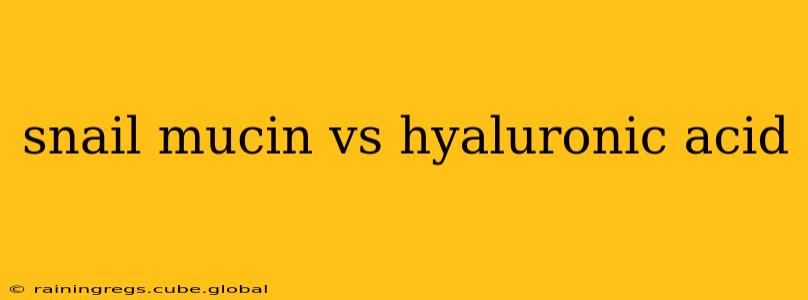Both snail mucin and hyaluronic acid are celebrated in the skincare world for their remarkable hydrating properties. But which one is the right choice for your skin? This in-depth comparison will explore the benefits, differences, and potential drawbacks of each ingredient, helping you make an informed decision for your skincare routine.
What is Snail Mucin?
Snail mucin is a secretion produced by snails, rich in a variety of beneficial compounds. It's not just slimy; it’s a complex mixture containing hyaluronic acid, glycolic acid, copper peptides, and various proteins and antioxidants. These components work synergistically to promote skin health. The purported benefits often include improved hydration, reduced wrinkles, scar reduction, and soothing irritated skin. However, the scientific evidence supporting all these claims is still emerging.
What is Hyaluronic Acid?
Hyaluronic acid (HA) is a naturally occurring substance in the body, primarily found in the skin's connective tissues. Its primary function is to attract and retain moisture, keeping the skin plump and hydrated. In skincare, HA is used as a humectant, meaning it draws water from the environment to the skin's surface. This results in improved hydration, reduced dryness, and a smoother, more youthful appearance. Unlike snail mucin, the effectiveness of HA in skincare is well-documented by numerous studies.
Snail Mucin vs. Hyaluronic Acid: Key Differences
While both ingredients are excellent moisturizers, they differ significantly in their composition and mechanism of action:
| Feature | Snail Mucin | Hyaluronic Acid |
|---|---|---|
| Source | Snail secretions | Synthesized or naturally derived |
| Composition | Complex mixture of HA, glycolic acid, proteins, etc. | Primarily hyaluronic acid |
| Mechanism | Hydration, wound healing, anti-inflammatory | Hydration, plumping, moisture retention |
| Texture | Often slightly thicker, potentially sticky | Can vary from lightweight serums to thicker gels |
| Potential Benefits | Hydration, scar reduction, anti-aging, soothing | Hydration, improved skin texture, anti-aging |
What are the benefits of using snail mucin?
Snail mucin's popularity stems from its purported ability to:
- Hydrate the Skin: The hyaluronic acid and other humectants within snail mucin draw moisture to the skin.
- Reduce the Appearance of Scars: Some studies suggest it may promote wound healing and reduce scar tissue formation.
- Soothe Irritated Skin: Its anti-inflammatory properties can be beneficial for sensitive or acne-prone skin.
- Improve Skin Elasticity: The proteins and copper peptides may contribute to improved skin firmness.
What are the benefits of using hyaluronic acid?
Hyaluronic acid offers a range of skincare benefits, primarily centered around hydration:
- Intense Hydration: Its ability to hold up to 1000 times its weight in water makes it a powerful humectant.
- Improved Skin Texture: Increased hydration leads to smoother, softer skin.
- Reduced Appearance of Fine Lines and Wrinkles: Plumping the skin can minimize the appearance of wrinkles.
- Suitable for All Skin Types: Generally well-tolerated by most skin types, making it a versatile ingredient.
Which is better for acne-prone skin?
Both snail mucin and hyaluronic acid can be beneficial for acne-prone skin, but in different ways. Hyaluronic acid primarily hydrates, which can help prevent dryness that can exacerbate acne. Snail mucin, with its potential anti-inflammatory and wound-healing properties, may help soothe blemishes and reduce redness. However, it's crucial to choose products formulated specifically for acne-prone skin to avoid potential breakouts. Always perform a patch test before applying any new product to your face.
Can I use both snail mucin and hyaluronic acid together?
Yes, you can use both snail mucin and hyaluronic acid together. In fact, many skincare enthusiasts find that combining them enhances their hydrating and rejuvenating effects. However, the order of application matters. Apply hyaluronic acid first, followed by snail mucin. This ensures the hyaluronic acid effectively draws moisture to the skin before the snail mucin seals it in.
Are there any side effects of using snail mucin or hyaluronic acid?
While generally well-tolerated, some individuals may experience mild side effects such as redness, irritation, or allergic reactions. Always perform a patch test before applying a new product to your entire face. If you experience any adverse reactions, discontinue use and consult a dermatologist.
Conclusion
Both snail mucin and hyaluronic acid are excellent moisturizing ingredients with unique benefits. The best choice for you depends on your specific skin concerns and preferences. If you're looking for a comprehensive approach to hydration and skin rejuvenation, combining both ingredients might be the most effective strategy. Remember to always choose high-quality products and perform a patch test before applying any new skincare product to your face.
